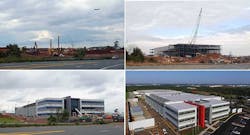ASHBURN, Va. – It’s known as a “greenfield” data center. But it all starts with dirt.
In this case, it begins with a 24-acre land parcel in Ashburn, Virginia in the world’s busiest concentration of cloud computing infrastructure. In less than a year, this piece of open land was transformed into a data center housing servers to deliver Internet services.
It’s a process that is happening across Ashburn, and in many other locations around the world. As the digital transformation of the global economy continues, it will be repeated often. Building the Internet of bits and bytes requires concrete and steel.
Here’s a closer look at the creation of a data center, from dirt to cloud.
The story begins near the nerve center of the Internet, about a mile from an Equinix data center campus where all the world’s networks meet. Just across the street is the campus of Oath, whose America Online service became the gateway to the Internet for tens of millions of many Americans.
The property was unused for years. But its destiny shifted in 2016, amid a boom in cloud computing, which in turn boosted demand for more servers and storage devices and the data centers to house them. A land grab emerged in Ashburn, as developers began to buy up properties around the Equinix connectivity hub.
Among them was David Tolson, a developer of luxury condominiums who had shifted his focus to data center real estate. Tolson’s development company DBT-DATA acquired the property on Broderick Drive, convinced that Data Center Alley would see an influx of new data center providers. Tolson began working with Dominion Power and Loudoun County officials to put power and entitlements in place, convinced the site would be ideal for a data center provider.
“If you look at the last three years and all the leasing that’s taken place, all these companies envy that and want a piece of it,” Tolson told Data Center Frontier in early 2017. “Ultimately, they will all be in Ashburn.”
Moving Dirt
In early 2017, QTS Data Centers was restructuring its business to focus on the largest hyperscale operators, who were leasing large chunks of “plug-and-play” IT capacity. The company was known for Internet-scale retrofits of existing industrial buildings, but was seeking a greenfield opportunity for its first company-built facility in Ashburn, dubbed Project Joshua.
QTS acquired the property for $17 million, and began work on the site on July 5, 2017. Blasting and earthwork got underway before the end of July.
The future site of the QTS Ashburn data center, September 2017. (Photo: Rich Miller)
QTS began driving piles for the building’s foundation on August 31, as seen in process in the photo above, which was taken on September 17.
QTS Ashburn is the first three-story data center in Data Center Alley, as Loudoun County has recently revised policies limiting data centers to two stories. The QTS greenfield design features 360,000 square feet of technical and equipment space, featuring 180,000 square feet of data center spread across 12 column-free data halls. The building also has 60,000 square feet of office space, housing QTS staff and workspaces for tenants. The building can support up to 32 megawatts of IT capacity.
The site in February 2018, as the superstructure begins to take shape. (Photo: Rich Miller)
On Sept. 15, QTS and its contractors began laying the hardened foundation and concrete flooring, and erecting the 70-foot panels of pre-cast concrete for the tilt-up walls enclosing the facility, which each weigh 21 tons (42,000 pounds). The construction team was able to erect eight or nine panels each day, with 400 panels being used in the project.
On Oct. 9 the company began putting up three stories of steel framing and roofing. QTS used 5,050 tons of steel to create the data center. The photo above was taken on Feb. 1, just prior to the “topping out” ceremony on Feb. 6 to mark the completion of the steel work.
As of early June 2018, tenants are being installed, even as cosmetic finishes continue. (Photo: Rich Miller)
All that concrete and steel create a sturdy physical shell to support the IT gear for Internet businesses, including tons of cabinets housing servers, storage equipment and networking gear. It also supports power and cooling equipment, including chillers and UPS units.
Another critical function of the building is to connect that IT equipment to the power grid and the fiber networks that connect to the Internet. The power infrastructure features electrical wiring and conduit to house and protect it – lots and LOTS of it. QTS Ashburn uses 250,000 feet of large electrical conduits (larger than 1.25 inches) and 500,000 feet of smaller electrical conduits – grand total of 142 miles of conduit.
The project features more than 2 million feet of electrical wire – about 378 miles worth – running within those conduits. More than 400,000 electrical nuts and washers were used to secure the power infrastructure in place, according to QTS.
The first tenant began moving in on May 20, 2018, several weeks before the above photo was taken on June 1.
An aerial view of the completed QTS Ashburn data center in September, 2018. (Photo: QTS Data Centers)
QTS Ashburn delivered its first space just 10 months after it began “moving dirt” and laying the foundation. Up to 550 workers were on the site each day, and the project has used 785,000 people hours to date. Contractors on the project included Turner Construction and Dynalectric.
Once this building is filled, the 24-acre property will support a second 16-megawatt data center. About 1,000 yards to the West, QTS owns a 28-acre property, where it plans to deploy another 105 megawatts of capacity. In March, QTS acquired 61 acres of vacant land in Manassas in nearby Prince William County, where it is building a new campus that will support more than 85 megawatts of power.
For more on the QTS Ashburn project, see our earlier coverage:
About the Author


